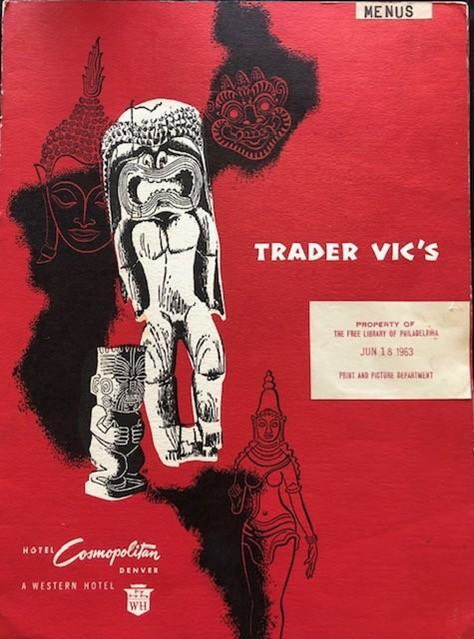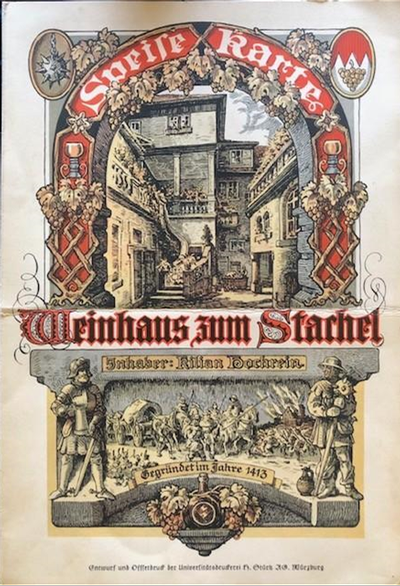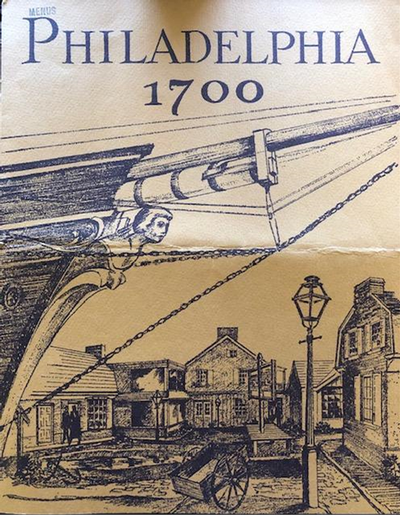Join us Wednesday, June 5, 2024 in the Print and Picture Collection for a hands-on history event inspired by We Are What We Eat, the latest exhibition from the Free Library's Special Collections.
Drop in anytime between 4:30 p.m. and 6:30 p.m. to see menus from Philadelphia landmarks, international airlines, and transatlantic ships.
Below is a taste of what will be on view:
Trader Vic’s

A favorite menu amongst our staff is from the restaurant chain Trader Vic’s. Tiki culture gained popularity at the end of Prohibition. The Trader Vic’s website states, “Decades ahead of his time, Vic ‘The Trader’ Bergeron chose to offer Chinese dishes alongside the then-contemporary Continental cuisine, creating the original fusion menu.” Trader Vic claims to have created the original Mai Tai in 1944. The story is that he concocted a rum drink and served it to a guest who, upon tasting it, said “Mai Tai Roa Ae!” or “Out of this world!” in Tahitian. Our menu is from the Hotel Cosmopolitan in Denver, Colorado which was demolished in 1984. Once extremely popular in the United States, as of 2024, there are three Trader Vic's restaurants in the United States, two in Europe, ten in the Middle East, two in Asia, and one in Africa.
Air India

Several menus from air and ship travel feature in the hands-on history event. The menu from Air India stood out to me for two reasons: the art and the food. Indian artists were specially hired to paint murals adorning the interiors of their 747s. On the Air India menu cover is a full-color detail of a mural titled “Roadside Siesta” by A.A. Raiba. An established artist, A.A. Raiba was born in Bombay, Maharashtra, in 1922 and is a graduate of Bombay’s Sir J.J. School of Art. Many of his paintings are in collections at the Cairo Museum in Egypt, the National Gallery of Modern Art in Delhi, and the Nagpur Museum in Madhya Pradesh. The menu offers dishes of chicken korma, pea pilau, and mushroom marsala! Fun fact: Spanish surrealist artist Salvador Dali designed an ashtray for Air India’s premium travel cabins.
Weinhaus Zum Stachel

A German menu written in Gothic script with ornate drawings stumped me. Inside, beside the entrees, the prices were written by hand, the ink now faded. After some time, I was able to make out “Weinhaus zum Stachel” on the cover or, translated to English, “Winehouse to the Sting.” Founded in 1413, this restaurant still exists today! It is the oldest inn in Würzburg and the oldest wine bar in Germany. Lore has it that in 1525, during the Peasants' War, it served as a meeting place for citizens rebelling against the nobility and clergy. At these gatherings, a morning star (a medieval weapon with a shaft and spiked ball), also called a "Stachel", was hanging out of the window. A recent write-up of the restaurant describes it as a “fine dining spot that offers traditional Franconian cuisine with a modern twist” with a “cozy and romantic ambiance, complete with wood panel walls and stained-glass windows. The interior design is reminiscent of a Romeo and Juliet novel.” According to the write-up, Riesling soup, Franconian black pudding, pork medallions with sausage and bacon, and blaue zipfel are the must-haves.
Philadelphia 1700

The menu that I left for last had a cryptic “Philadelphia 1700” on the front and inside the words “A part of Old Philadelphia recreated for your dining pleasure.” By a stroke of luck, I found a WordPress page online called Philly Flashbacks. A post from February 15, 2014, titled "Lost Philadelphia; 1700" solved our mystery. Apparently, in 1965, a colonial complex was built on Pier 37 with restaurants, shops, and businesses. You could visit a blacksmith, a candlemaker, a baker, and a small tobacco shop. The complex closed in 1971 and our menu was added to the collection in 1974. This destination point on the Delaware River lasted only six years!
Menus are such fascinating ephemera. They were not intended to be saved but instead served one specific purpose. Nowadays, many restaurants don’t offer menus to take away. In fact, some are doing away with paper menus entirely, using QR codes or similar technology. The menus above offer a snapshot in time, a lens into what everyday life was like for those before us, reflecting not just our eating habits, but also representing our communities. As we increasingly move away from the physical to the digital, what will future generations collect to look back at us? Hopefully, whatever we leave will be as charming and intriguing as these menus!
To explore more about the way cuisine intertwines with culture, attendees are encouraged to view We Are What We Eat in the Dietrich Gallery on the Third Floor of Parkway Central Library. The Rare Book Department will have special late evening hours, offering a behind-the-scenes tour at 6:30 p.m.
Have a question for Free Library staff? Please submit it to our Ask a Librarian page and receive a response within two business days.

